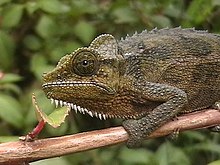This article needs additional citations for verification. (March 2024) |
Trioceros hoehnelii, commonly known as von Höhnel's chameleon, the helmeted chameleon, and the high-casqued chameleon, is a species of chameleon, a lizard in the family Chamaeleonidae. The species is native to eastern Africa.
| Trioceros hoehnelii | |
|---|---|

| |
| Scientific classification | |
| Domain: | Eukaryota |
| Kingdom: | Animalia |
| Phylum: | Chordata |
| Class: | Reptilia |
| Order: | Squamata |
| Suborder: | Iguania |
| Family: | Chamaeleonidae |
| Genus: | Trioceros |
| Species: | T. hoehnelii
|
| Binomial name | |
| Trioceros hoehnelii (Steindachner, 1891)
| |
| Synonyms[2] | |
Etymology
editBoth the specific name, hoehnelii, and one of the common names, "von Höhnel's chameleon", are in honor of Austrian explorer Ludwig von Höhnel (1857–1942).[3][4]
Geographic range
editIdentification
editT. hoehnelii is a small to medium-size chameleon, growing up to 10 inches (25.4 cm) in total length (including tail). Coloration is highly variable across its geographic range. During morning hours, it may be seen basking in the sunlight, almost completely black in color to capture heat energy from the sunlight. This species has a single horn on the rostrum, a serrated back crest, and a spiny throat crest.[5] Males are typically larger than females with a larger casque, horn, and enlarged tail base.[citation needed]
Behavior
editMost chameleons in east Africa tend to be territorial and the high-casqued chameleon is no different. If males are placed together, they will hiss at each other, turn black, and compress their bodies to make them look larger. Dominant males display brightly colored patterns that differ from females or subordinate males, which often persist until they are defeated during a courtship battle.[6]
Reproduction
editT. hoehnelli bears live young via ovoviviparity.[2] Sexually mature adults form stable pair bonds during the mating season, which endure throughout the five months of pregnancy. After the birth, the pair usually splits up.[7]
Diet
editThe high-casqued chameleon eats most small insects and spiders, and does so by extending the tongue to capture the prey. It is capable of extending the tongue more than a complete body length.[citation needed]
References
edit- ^ a b Tolley, K. (2014). "Trioceros hoehnelii ". IUCN Red List of Threatened Species. 2014: e.T176315A47633405. doi:10.2305/IUCN.UK.2014-3.RLTS.T176315A47633405.en. Retrieved 11 November 2021.
- ^ a b Trioceros hoehnelii at the Reptarium.cz Reptile Database
- ^ Steindachner F (1891). "Über einege neue und seltene Reptilien- und Amphibien-Arten. Bericht über die von Herrn Linienschiffsleutenant Ritter von Höhnel während der Graf Samuel Telekis ostafrikanischer Expedition gesammelten Reptilien". Sitzungsberichte der Kaiserlichen Akademie der Wissenschaften. Mathematisch-Naturwissenschaftliche Classe. Abteilung I (in German). 100 (1): 291–316 + Plates I–III. (Chamael[e]on höhnelii, new species, pp. 309–311 + Plate I, figures 1, 1a)
- ^ Beolens, Bo; Watkins, Michael; Grayson, Michael (2011). The Eponym Dictionary of Reptiles. Baltimore: Johns Hopkins University Press. xiii + 296 pp. ISBN 978-1-4214-0135-5. (Chameleo hoehnelii, p. 124).
- ^ Bartlett, Richard D.; Bartlett, Patricia (2005), Chameleons: Everything about Purchase, Care, Nutrition, and Breeding, Barron's Educational Series, p. 73, ISBN 0-7641-2863-9.
- ^ Gans, Carl (1992), Biology of the Reptilia, University of Chicago Press, pp. 350–351, ISBN 0-226-28124-8.
- ^ Toxopeus AG, Kruijt JP, Hillenius D (1988). "Pair-bonding in chameleons". Naturwissenschaften. 75 (5): 268–269. Bibcode:1988NW.....75..268T. doi:10.1007/BF00378024. S2CID 7929382.
